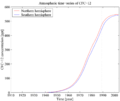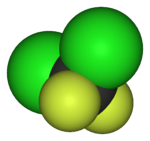Dichlorodifluoromethane
| |||
| Names | |||
|---|---|---|---|
| IUPAC name
Dichlorodifluoromethane | |||
| Other names
Carbon dichloride difluoride, Dichloro-difluoro-methane, Difluorodichloromethane, Freon 12, R-12, CFC-12, P-12, Propellant 12, Halon 122, Arcton 6, Arcton 12, E940, Fluorocarbon 12, Genetron 12, Refrigerant 12 | |||
| Identifiers | |||
| 75-71-8 | |||
| ChEMBL | ChEMBL2106634 | ||
| ChemSpider | 6151 | ||
| EC number | 200-893-9 | ||
| |||
| Jmol-3D images | Image | ||
| KEGG | D03789 | ||
| PubChem | 6391 | ||
| RTECS number | PA8200000 | ||
| |||
| UNII | OFM06SG1KO | ||
| UN number | 1028 | ||
| Properties | |||
| Molecular formula |
CCl2F2 | ||
| Molar mass | 120.91 g·mol−1 | ||
| Appearance | Colorless gas with ether-like odor | ||
| Odor | ether-like at very high concentrations | ||
| Density | 1.486 g/cm³ (−29.8 °C (−21.6 °F)) | ||
| Melting point | −157.7 °C (−251.9 °F; 115.5 K) | ||
| Boiling point | −29.8 °C (−21.6 °F; 243.3 K) | ||
| 0.286 g/l at 20 °C (68 °F) | |||
| Solubility in alcohol, ether, benzene, acetic acid | Soluble | ||
| log P | 2.16 | ||
| Vapor pressure | 568 kPa (20 °C (68 °F)) | ||
| Henry's law constant (kH) |
0.0025 mol kg−1 bar−1 | ||
| Hazards | |||
| MSDS | External MSDS | ||
| Main hazards | Damaging to Earth's protective ozone | ||
| EU Index | Not listed | ||
| R-phrases | R44 R59[1] | ||
| S-phrases | S9 S38[1] | ||
| Flash point | Non-flammable [2] | ||
| US health exposure limits (NIOSH): | |||
| PEL (Permissible) |
TWA 1000 ppm (4950 mg/m3)[2] | ||
| REL (Recommended) |
TWA 1000 ppm (4950 mg/m3)[2] | ||
| IDLH (Immediate danger) |
15000 ppm[2] | ||
| Supplementary data page | |||
| Refractive index (n), Dielectric constant (εr), etc. | |||
| Thermodynamic data |
Phase behaviour solid–liquid–gas | ||
| UV, IR, NMR, MS | |||
| Except where noted otherwise, data is given for materials in their standard state (at 25 °C (77 °F), 100 kPa) | |||
| | |||
| Infobox references | |||
Dichlorodifluoromethane (R-12) is a colorless gas usually sold under the brand name Freon-12, and a chlorofluorocarbon halomethane (CFC) used as a refrigerant and aerosol spray propellant. Complying with the Montreal Protocol, its manufacture was banned in the United States along with many other countries in 1996 due to concerns about its damaging impact to the ozone layer.[3] It is soluble in many organic solvents. Dichlorodifluoromethane was one of the original propellants for Silly String. R-12 cylinders are colored white.
Preparation
It can be prepared by reacting carbon tetrachloride with hydrogen fluoride in the presence of a catalytic amount of antimony pentachloride:
CCl4 + 2HF → CCl2F2 + 2HCl
This reaction can also produce trichlorofluoromethane (CCl3F), chlorotrifluoromethane (CClF3) and tetrafluoromethane (CF4).[4]
Use as an aerosol
The use of chlorofluorocarbons as aerosols in medicine, such as USP-approved salbutamol, has been phased out by the U.S. Food and Drug Administration. A different propellant known as hydrofluoroalkane, or HFA, which is not known to harm the environment, was chosen to replace it.[5]
Retrofitting
R-12 was used in most refrigeration and vehicle air conditioning applications prior to 1994 before being replaced by 1,1,1,2-tetrafluoroethane (R-134a), which has an insignificant ozone depletion potential. 1992–1994 was the time period in which automobile manufacturers started using R-134a instead of R-12. When older units leak, retrofits to R-134a are recommended. Retrofit to R-134a requires complete flushing and filter/dryer replacement to remove the mineral oil. Mineral oil used for R12 is not compatible with R-134a. Some oils designed for conversion to R-134a are advertised as compatible with residual R-12. New rubber hoses which are R-134a compatible may be needed for the same reason.
In systems where R-134a is not practical, an R-409A blend (60% R-22; 25% R-124; 15% R-142b) may be directly added to an R-12 system without changing the oil, although a filter change is always recommended. R-409A usually runs on the low-pressure side of the system at 12 pounds per square inch (psi), while R-12 usually runs on the low side at 10 psi. R-409A runs at higher pressures and is less efficient but works quite well. Manufacturers recommend that the existing R-12 charge be recovered. However, as the two refrigerants are soluble in the same mineral oil, there are no complications associated with mixing them. Note that the instructions for R-409A recommend charging a system with liquid to keep the mixture ratios constant. The constituents have varying vapor pressures.
Gallery
-

Time-series of atmospheric concentrations of CFC-12 (Walker et al., 2000)
-

1990s sea surface CFC-12 concentration
-

1990s CFC-12 oceanic vertical inventory
-

CFC-12, CFC-11, H-1211 and SF6 vertical profiles
References
- ↑ 1.0 1.1 "Dichlorodifluoromethane MSDS" (PDF). Synquest Labs.
- ↑ 2.0 2.1 2.2 2.3 "NIOSH Pocket Guide to Chemical Hazards #0192". National Institute for Occupational Safety and Health (NIOSH).
- ↑ Dichlorodifluoromethane at LearnChemistry (Royal Society of Chemistry)
- ↑ Greenwood, Norman N.; Earnshaw, Alan (1997). Chemistry of the Elements (2nd ed.). Butterworth-Heinemann. p. 304. ISBN 0080379419.
- ↑ 'Rescue' asthma inhaler replacements coming to Pa.
External links
- NOAA/ESRL CFC-12 global measurements
- International Chemical Safety Card 0048
- Overview of Freon-12 and some of its environmental problems
- MSDS at Oxford University
- Thermochemistry data at chemnet.ru
- IR absorption spectra
- CDC - NIOSH Pocket Guide to Chemical Hazards
| ||||||
| ||||||||||||||||||||||

